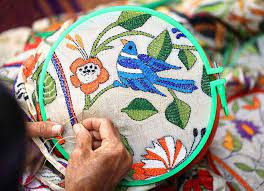
{Image Source - Feminism India}
The history of Indian embroidery is as epic as the embroidery style. Previously, bronze needles were used for stitching and were discovered at Mohenjodaro between 2500 and 1500 B.C. Another significant piece of evidence is a stone figure of a bearded priest wearing a trefoil-patterned scarf discovered in Mohenjodaro. The Ajanta cave paintings include evidence of embroidered clothes from the early medieval period. Scarves, skirts, and a variety of tunic and jacket styles were seen.
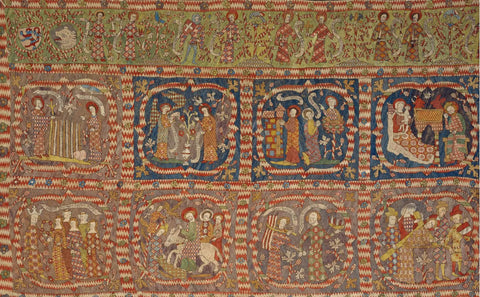 {Image source - Superprof}
{Image source - Superprof}
The process of tailoring, patch-making, and mending fabric promoted the creation of new sewing methods and, ultimately, the artistic method of embroidery. Exploration of these embroidering skills and techniques is a fantastic way to learn about India's cultural roots. Therefore, here are the famous embroideries of India-
Chikankari - It is a well-known example of white-work floral embroidery and is constructed using 35 various stitches, including flat, raised, embossed, and jaalis-like stitches on textiles like muslin, cotton, or linen. It is an essential art that stems from Lucknow's life and culture, or "Nawabo ka sheher," and the demand for chikankari-embroidered clothing has significantly increased in the global fashion market. The designs are based on flora and fauna found in nature, such as peacocks, parrots, mangos, five-petalled flowers, creepers, jasmine, and lace-like patterns.
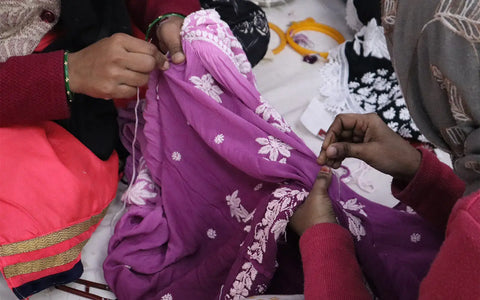 {Image source - istitutomarangoni}
{Image source - istitutomarangoni}
Phulkari - The embroidery is done using a long-and-short darn stitch, which is done from the underside of the cloth and produces a lovely effect on the fabric. The patterns show vibrant themes that are embroidered with this technique. The thread comes in a variety of colors, including red, green, golden yellow, orange, blue, and white. Phulkari, which translates to "a garden of flower works," is traditionally done on hand-spun khadi cloth that has been dyed in brightly colored threads in shades of red, yellow, blue, green, and darker shades. However, it is now done on a variety of fabrics, including georgettes, chiffons, cotton, and synthetic fabrics to make sarees, suits, and dupattas.
 {Image source- Hindustan Times}
{Image source- Hindustan Times}
Zardozi - Some common patterns include creepers, blooming bushes, flowery scrolls, and elaborate jali patterns. The motifs combine floral and geometrical elements. Zardosi's hand threadwork embroidery design is expensive but a great investment. Previously considered a sign of wealth, this handiwork is now more widely available since synthetic threads colored gold are substituted.
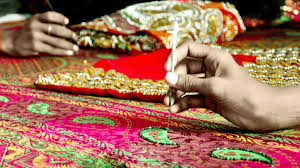 {Image source - Sociotab}
{Image source - Sociotab}
Shisha - Mirror work or shisha embroidery is a famous local craft of Gujarat. It was found in the 17th Century and was first done by using Mica. Mica was later replaced by glass. Islamic traditions have inspired the Shisha needlework of Balochistan, which is nearly entirely geometric and done with cotton thread on dense cotton fabric. It was traditionally dyed with natural materials, which produced subdued color schemes. Shisha embellishes both casual and festive wear. Shisha embroidery describes the cultural essence of Gujarat, Rajasthan, and Uttar Pradesh.
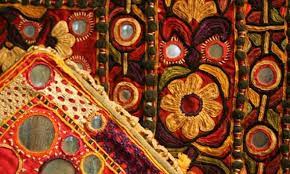
Kantha - The Bengali traditional folk art, Kantha, meaning "Patched Cloth," is well-known. There are two different kinds of embroidery. In the first kind, quilting and embroidery are done on a pile of used, old cotton saris/dhotis. The design is first traced, and then colored threads from the saris' colored borders are used to fill in the gaps. Traditional colors like black, deep blue, and red, which represent nature, earth, sky, and space, respectively, are added to the embroidery to create rich textural effects. Black thread is occasionally used to create the design's outline and other times to fill it in with matching-colored threads. The Kantha design is inspired by daily life and includes folk tales, epics, mythical settings, ceremonial themes, lush greenery with wandering animals, fine jewelry, various sorts of attire, and more.
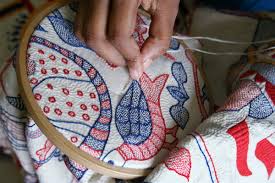 {Image source - artsandculture}
{Image source - artsandculture}
Kasuti - The state of Karnataka is known for its beautiful kasuti embroidery, Kasuti. In the Karnataka language, Kasut is handwork made with cotton thread. Kai means hand and Suti mean thread. These are the 5 garments on which Kasuti is done—a kunchi (bonnet and cape combined), lenga (skirt), seragu (sari pallav), kusuba (body), and kulai (bonnet). The sacred bull, elephant, and deer are used as animal themes. The gopurams of South India, as well as lotus flowers, raths, and palanquins, are used as motifs in Kasuti. Bird motifs like the parrot, peacock, swan, and squirrel are also frequently used.
 {Image source - Dayalbagh educationl institute }
{Image source - Dayalbagh educationl institute }
Kashida - Kashida embroidery, also known as Kasida, is one of the oldest and most traditional types of beautiful intrinsic art. It expresses its cultural essence via single stitch thread work technique and is most renowned in the ethnic region of Jammu and Kashmir. With multi-colored threads and beads weaved into sarees and kashida embroidery dupattas, exquisite embroidery includes birds, leaves, trees, and many other natural designs. The materials used for this needlework include silk, cotton, and wool.
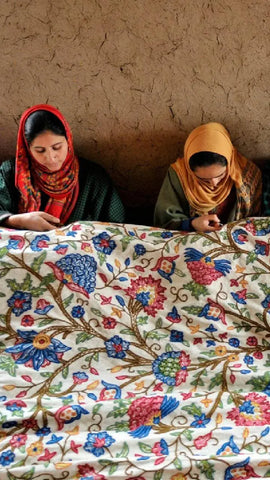 {Image source - NDTV}
{Image source - NDTV}
Hand Embroidery Vs Machine Embroidery
Hand embroidery is the process of designing a piece of cloth with colored threads and gorgeous beads. It is a kind of art in which beautiful patterns of design are created on cloth using needles and thread. The embroidered designs are exquisite and inspired by Mughal architecture. The patterns and themes are well represented by combining light color tones. Hand-embroidered dresses, dupattas, and suits look quite elegant.
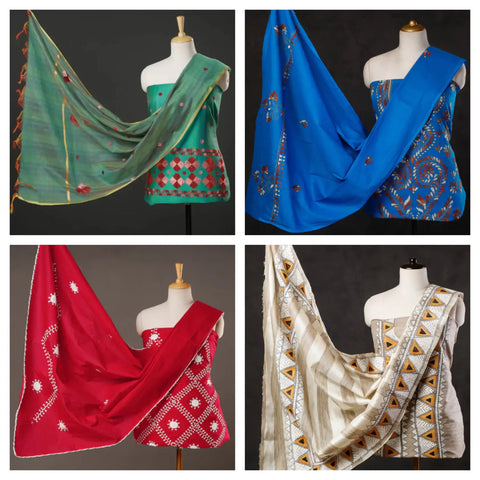
Nowadays, machine embroidery is in high demand and popularity. A unique sewing machine used to create embroidered designs on textiles is needed for machine embroidery. Free-motion and digital machine embroidery are the two most often used forms. Wool, cotton, or silk-stranded thread is used for hand embroidery. To make certain parts thinner, the strands can be split; for thicker areas, they can be merged. The embroidery has additional texture and distinctiveness between different sections as a result of this technique. The thread used in embroidery machines is often composed of polyester, metallics, or rayon and is thicker than the thread used for hand stitching. Since this thread is not stranded, it cannot be split to alter the texture of any embroidered element. The design will seem to flatter since it will have the same thickness throughout.
India has a wonderful range of creative traditions, including a variety of embroidery methods as diverse as our country and its numerous ethnicities. Every area has its specific style in which embroidery is valued as more than merely decoration but as a communication tool.
India has a wonderful range of creative traditions, including a variety of embroidery methods as diverse as our country and its numerous ethnicities. Every area has its specific style in which embroidery is valued as more than merely decoration but as a communication tool. To preserve India's rich and diverse culture and its enormous skill set, hand embroidery has to be promoted and protected.
Wanna buy some embroidered products? India’s largest and best authentic handicraft store has got you covered! Check out some amazing exquisite embroidery collections on iTokri!
Blogs you might also like:
Maharashtrian Tribal Art - Warli Paintings
Significance of Wearing Bangles in an Indian Society
Style Your Tradtional Outfits With India's 10 Most Popular Traditional Dupattas
REFERENCES
https://www.gktoday.in/topic/embroidery-art-of-india/https://www.worldartcommunity.com/blog/2019/08/the-craft-of-kutch-embroidery/
https://www.myindiamyglory.com/2018/04/19/talking-threads-story-of-indian-embroidery/
https://www.dsource.in/resource/hand-embroidery-ahmedabad/introduction
https://yehaindia.com/love-embroideries-checkout-the-14-exquisite-embroideries-of-india/
https://www.dsource.in/resource/hand-embroidery-ahmedabad
https://www.myindiamyglory.com/2018/04/19/talking-threads-story-of-indian-embroidery/
 Verified Purchase
Verified Purchase











































































































































































































Leave a comment (all fields required)